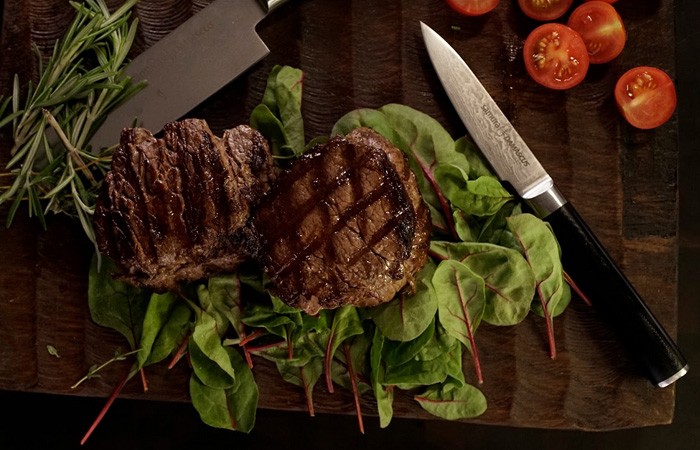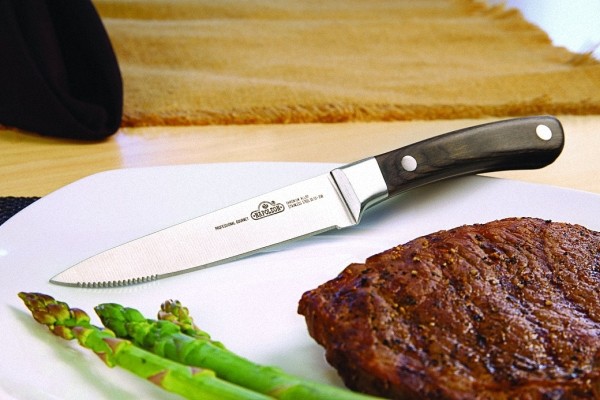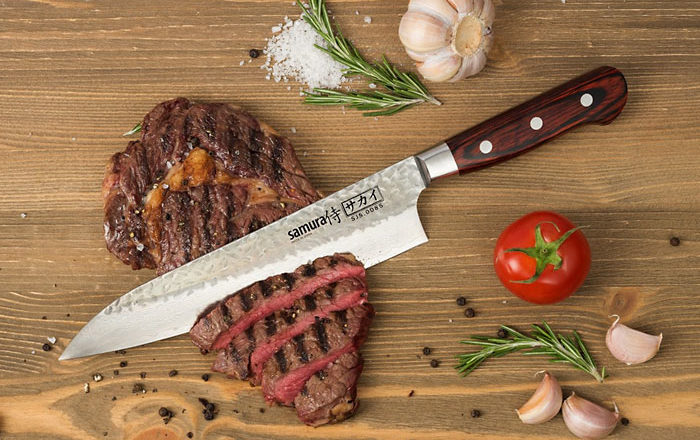Everything is simple-there is a tender steak and you need a knife to cut it. Of course, you can take any knife (for example, a table knife that has never been sharpened in your life), or you can choose one that is practical, convenient and will easily cut off the tenderest pieces from your steak, and not crush it, squeezing all the remaining juice from the meat fibers.
This knife is easy to distinguish from others!
Unlike the table knife, the classic steak knife has a longer blade with a high heel (to prevent the palm from slipping off) and the same blade width, sharply tapering to a pointed top. The massive handle is designed to provide ease of use.
Speaking of size, you can’t help but notice that the average blade length of a steak serving knife for meat is usually equal to the average length of the steak itself (10-12 cm). I will immediately note that there are also knives with a blade up to 18-22 they are not intended for serving, but for cutting a previously prepared large piece of meat and are successfully used for slicing (before serving to the client) on a wooden Board as steaks, roast beef, langets, escalopes, etc.

As a matter of fact, what is a steak? This is a piece of meat cut from a certain part of the carcass, at least 2 cm thick and an average length of 10-12 cm (this has already been mentioned). Once cooked, it has a beautiful brown, almost crispy crust and can have one of six degrees of roasting. The meat is known to have a fibrous structure and it is natural that steaks with a weak roasting require less effort to penetrate than steaks with a higher degree of roasting and retain less juice. Therefore, knives for steaks of different roasts have different characteristics of the cutting edge, which is designed to provide convenience when the blade penetrates the meat.
Remember the practicality and convenience? So, for cutting steaks with the degree of roasting BLUE RARE, RARE and MEDIUM RARE, a meat knife with a smooth surface is used, while for steaks with medium, MEDIUM WELL and WELL DONE-a steak knife with a gray sharpening (a link to the detailed table with all the degrees of roasting of steaks and their cooking temperature you will see at the end of the article).
It is very simple not to confuse knives when serving. The steaks retained more juice, usually served on wooden boards and knives are served with a smooth RK sharp blade with a sharpening angle of about 25-30° to easily cut the desired piece of the still-hot meat, and the Board will help to preserve the sharpness of the best knife (some sources say that such blades can have the angle 15-20° the author suggests that in such cases, it may be because Japanese art of working with the knife fore steak when cutting when there is no contact of the best knife for steak with Board)
Whereas more dry steaks are served in porcelain plates and knives are served with SANATORNO sharpening. This knife will not leave traces on the often expensive porcelain plate and easily cope with meat that almost (or completely) does not contain juice. In addition, sanatorny knife can stay sharp for a long time cut is not the tops of each clove of senatora, and faces the outline of the arc that when cutting you do not have contact with a plate and a long time is able to stay sharp. On such knives do not always pay attention to the sharpening angle, but for steak it is better to keep the above values in 25-30°
In conclusion, a few words about the steels used for making steak knives. Meat quickly “sets” the cutting edge, so steak knives with a smooth surface are recommended to buy with a steel hardness of 58-62HRC. When used correctly, this steel will keep the sharpness of the blades longer and make it more rare to visit the sharpener.
But sereytornye knives for steaks should be chosen with a steel blade hardness no higher than 56HRC. Their softer steel will help to avoid unnecessary scratches on porcelain plates, and the sereytor will provide comfort in using the steak knife for meat. by the way, on sale you can also find combined knives that combine a serizer and a smooth surface, for example, as the picture below:


